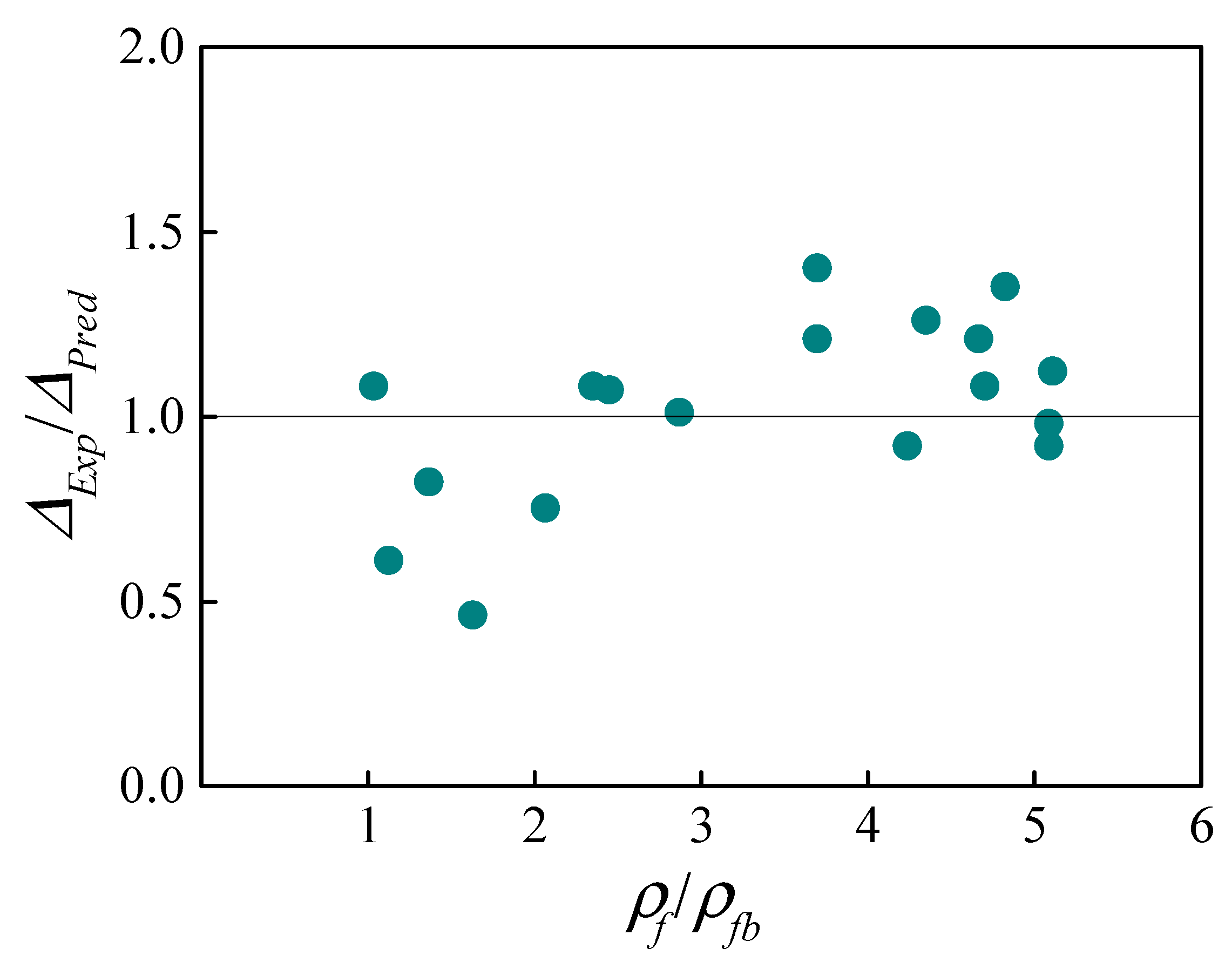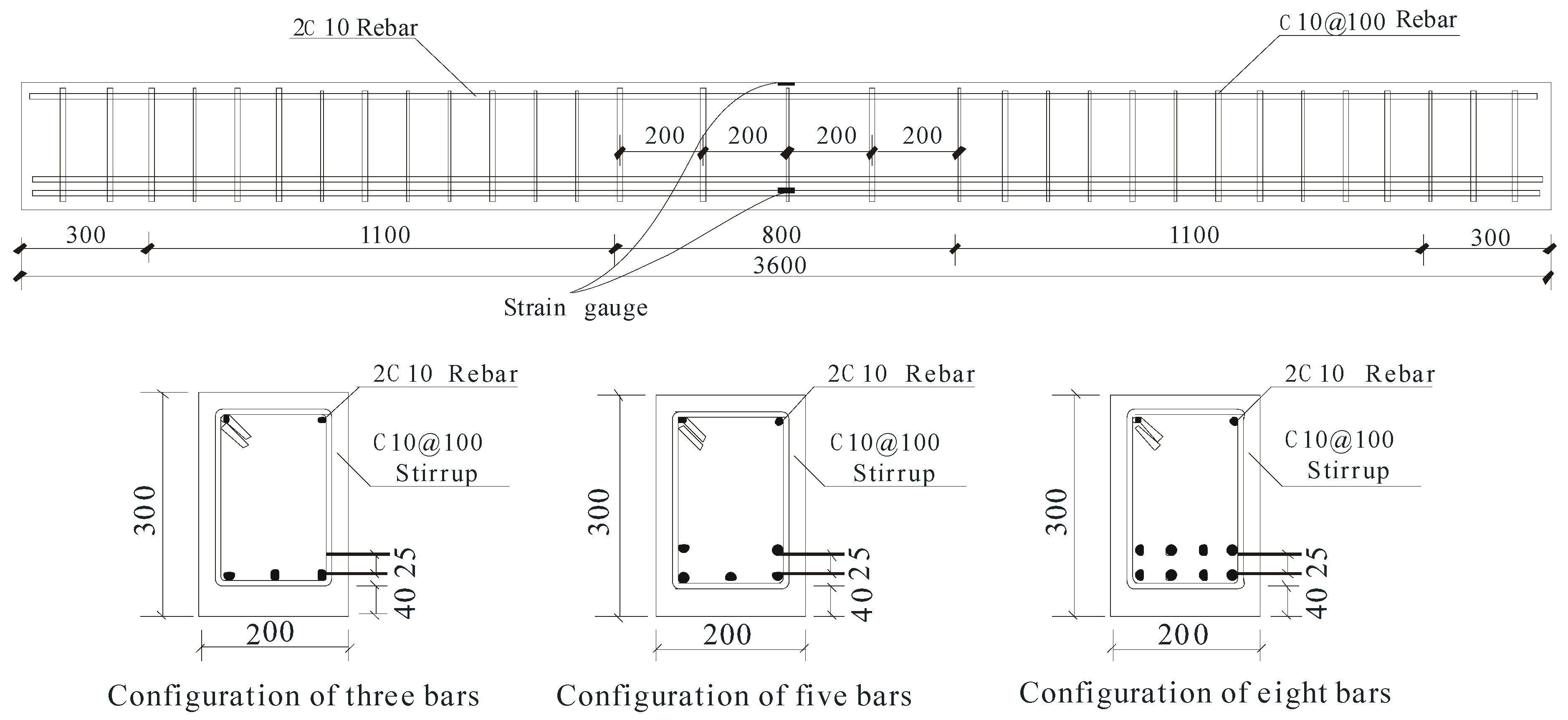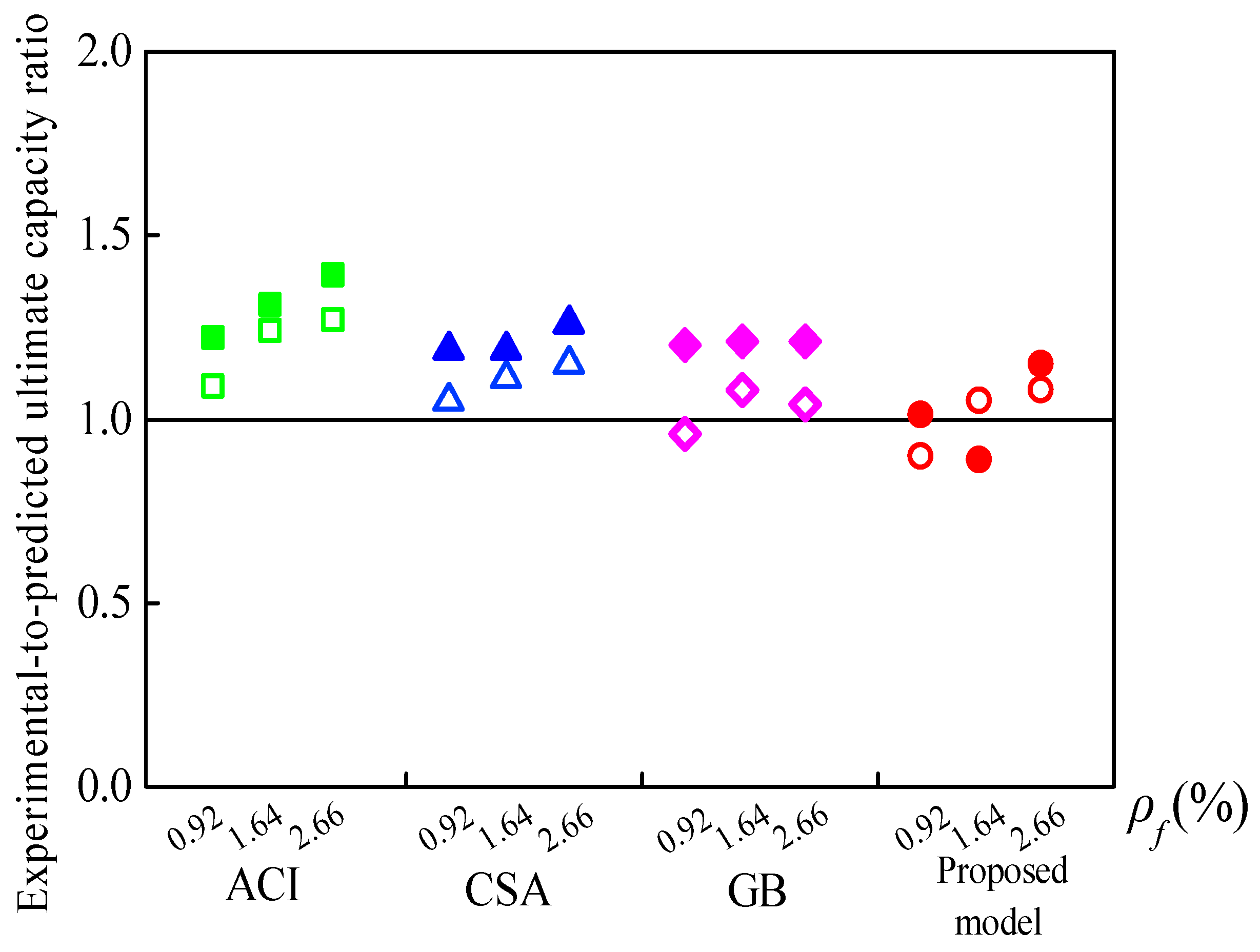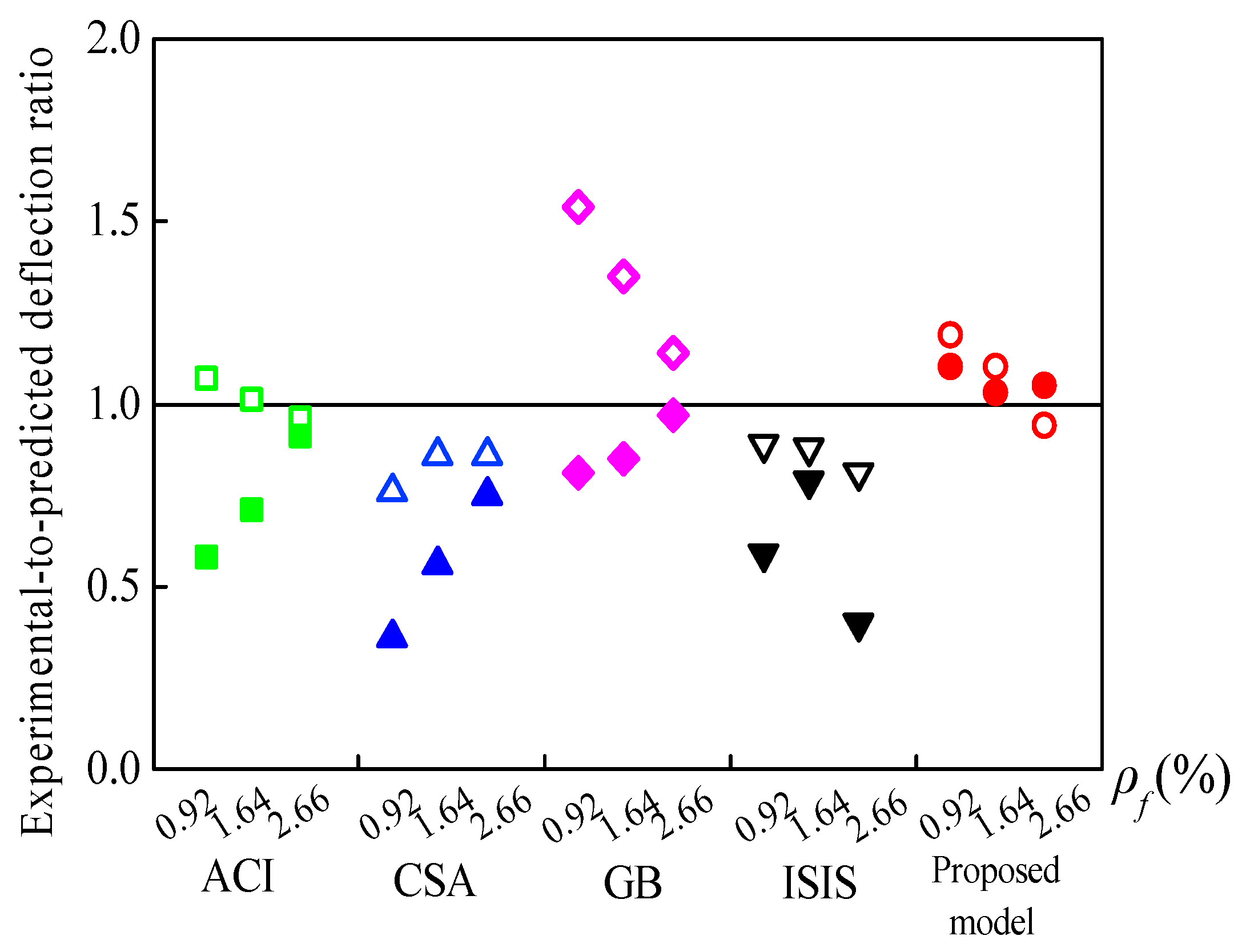Flexural Capacity and Deflection of Fiber-Reinforced Lightweight Aggregate Concrete Beams Reinforced with GFRP Bars
Abstract
:1. Introduction
2. Balanced Reinforcement Ratio and Ultimate Moment Model of FRP–FLWC Beams
2.1. Strain and Stress Conditions
- (1)
- Strain in the concrete and the FRP reinforcement is proportional to the distance from the neutral axis;
- (2)
- The tensile behavior of the FRP reinforcement is linearly elastic;
- (3)
- (4)
- The reinforcing steel rebar in the compression zone is yielded;
- (5)
- A perfect bond exists between concrete and FRP reinforcement.
2.2. Prediction for Balanced Failure Mode
2.3. Prediction for Concrete Crushing Failure Mode
3. Deflection Model of FRP-Reinforced Beams
3.1. Prediction for Beams without Fibers
3.2. Prediction for Beams Reinforced with Fibers
3.3. Verification Based on Fiber-Reinforced Normal Weight Concrete (FNWC) Beams
4. Models Recommended by Design Codes
4.1. Balanced Reinforcement Ratio and Ultimate Moment
4.2. Deflection
5. Experimental Study of GFRP-Reinforced LWC Beams
5.1. Test Specimens and Material Properties
5.2. Test Results
6. Comparison between the Experimental and Predicted Results
6.1. Balanced Reinforcement Ratio and Ultimate Moment of LWC Beams
6.2. Deflection of LWC Beams
7. Conclusions
- (1)
- Increasing the reinforcement ratio and adding steel fibers were shown to be effective in decreasing the FRP strain of FRP-reinforced LWC beams.
- (2)
- Design codes ACI 440.1R, ISIS-M03, GB 50608, and CSA S806 generally underestimated the flexural capacity of the GFRP-LWC beams with and without steel fibers. The predictions obtained from the proposed ultimate moment equation were in good agreement with the experimental results.
- (3)
- For GFRP-SFLWC beams, the design codes showed conservative deflection values at Ms, while the proposed short-term stiffness model provided reasonable predictions with low dispersion degree.
- (4)
- In both case of SFLWC and FNWC beams, specimens with higher ρf/ρfb tended to yield higher experimental-to-predicted deflection ratios based on the proposed model. Further research will be conducted involving rational consideration of the FRP reinforcement amount in the deflection model of fiber-reinforced beams.
Author Contributions
Funding
Conflicts of Interest
References
- Dong, Z.; Wu, G.; Xu, Y. Experimental study on the bond durability between steel-FRP composite bars (SFCBs) and sea sand concrete in ocean environment. Constr. Build. Mater. 2016, 115, 277–284. [Google Scholar] [CrossRef]
- Zheng, Y.; Yu, T.; Yang, J.; Li, Y.; Sun, C. Investigation of the behaviour of reinforcement-free concrete deck slabs restrained by FRP rods. Eng. Struct. 2017, 135, 191–208. [Google Scholar] [CrossRef]
- Zheng, Y.; Li, C.; Yang, J.; Yu, T.; Sun, C. Influence of arching action on shear behaviour of laterally restrained concrete slabs reinforced with GFRP bars. Compos. Struct. 2015, 132, 20–34. [Google Scholar] [CrossRef]
- Xia, L.; Zheng, Y. Deep embedment (DE) FRP shear strengthening of concrete bridge slabs under loads close to supports. Appl. Sci. 2018, 8, 721. [Google Scholar] [CrossRef]
- Xu, K.; Ren, C.; Deng, Q.; Jin, Q.; Chen, X. Real-time monitoring of bond slip between GFRP bar and concrete structure using piezoceramic transducer-enabled active sensing. Sensors 2018, 18, 2653. [Google Scholar] [CrossRef] [PubMed]
- Kayali, O. Fly ash lightweight aggregates in high performance concrete. Constr. Build. Mater. 2008, 22, 2393–2399. [Google Scholar] [CrossRef]
- Bogas, J.A.; Brito, J.D.; Cabaço, J. Long-term behaviour of concrete produced with recycled lightweight expanded clay aggregate concrete. Constr. Build. Mater. 2014, 65, 470–479. [Google Scholar] [CrossRef]
- Li, P.; Sui, L.; Xing, F.; Huang, X.; Zhou, Y.; Yun, Y. Effects of aggregate types on the stress-strain behavior of fiber reinforced polymer (FRP)-confined lightweight concrete. Sensors 2018, 18, 3525. [Google Scholar] [CrossRef]
- ACI 440.1R. Guide for the Design and Construction of Structural Concrete Reinforced with Fiber-Reinforced Polymer Bars; American Concrete Institute: Farmington Hills, MI, USA, 2015. [Google Scholar]
- CSA S806. Design and Construction of Building Structures with Fibre-Reinforced Polymers; Canadian Standards Association: Toronto, ON, Canada, 2012. [Google Scholar]
- Wang, H.Z.; Belarbi, A. Flexural durability of FRP bars embedded in fiber-reinforced-concrete. Constr. Build. Mater. 2013, 44, 541–550. [Google Scholar] [CrossRef]
- Lambrechts, A.; Nemegeer, D.; Vanbrabant, J.; Stang, H. Durability of steel fibre reinforced concrete. Spec. Publ. 2003, 212, 667–684. [Google Scholar]
- Yang, J.M.; Min, K.H.; Shin, H.O.; Yoon, Y.S. Effect of steel and synthetic fibers on flexural behavior of high-strength concrete beams reinforced with FRP bars. Compos. Part. B Eng. 2012, 43, 1077–1086. [Google Scholar] [CrossRef]
- Issa, M.S.; Metwally, I.M.; Elzeiny, S.M. Influence of fibers on flexural behavior and ductility of concrete beams reinforced with GFRP rebars. Eng. Struct. 2011, 33, 1754–1763. [Google Scholar] [CrossRef]
- Faza, S.S.; Ganga Rao, H.V.S. Bending and bond behavior of concrete beams reinforced with plastic rebars. Transport. Res. Rec. 1990, 1, 185–193. [Google Scholar]
- Yoo, D.Y.; Banthia, N.; Yoon, Y.S. Predicting service deflection of ultra-high-performance fiber reinforced concrete beams reinforced with GFRP bar. Compos. Part B 2016, 99, 381–397. [Google Scholar] [CrossRef]
- Zhu, H.T.; Cheng, S.Z.; Gao, D.Y.; Neaz, S.M.; Li, C. Flexural behavior of partially fiber-reinforced high-strength concrete beams reinforced with FRP bars. Constr. Build. Mater. 2018, 161, 587–597. [Google Scholar] [CrossRef]
- ACI 544.4R. Guide to Design with Fiber-Reinforced Concrete; American Concrete Institute: Farmington Hills, MI, USA, 2018. [Google Scholar]
- JGJ12-2006. Technical Specification for Lightweight Aggregate Concrete Structures; China Engineering and Construction Society Press: Beijing, China, 2006. [Google Scholar]
- GB 50608. Technical Code for Infrastructure Application of FRP Composites; China Planning Press: Beijing, China, 2010. [Google Scholar]
- Zhu, H.; Dong, Z.Q.; Wu, G.; Wu, Z.S. Experimental study and theoretical calculation on the flexural stiffness of concrete beams reinforced with FRP bars. Chin. Civ. Eng. J. 2015, 48, 44–53. [Google Scholar]
- Oh, B.H. Flexural Analysis of Reinforced Concrete Beams Containing Steel Fibers. J. Struct. Eng. 1992, 118, 2821–2836. [Google Scholar] [CrossRef]
- El-Nemr, A.; Ahmed, E.A.; Benmokrane, B. Flexural behavior and serviceability of normal- and high-strength concrete beams reinforced with glass fiber-reinforced polymer bars. ACI Struct. J. 2013, 110, 1077–1087. [Google Scholar]
- Rashid, M.A.; Mansur, M.A.; Paramasivam, P. Behavior of aramid fiber-reinforced polymer reinforced high strength concrete beams under bending. J. Compos. Constr. 2005, 9, 117–127. [Google Scholar] [CrossRef]
- Saikia, B.; Kumar, P.; Thomas, J.; Rao, K.S.N.; Ramaswamy, A. Strength and serviceability performance of beams reinforced with GFRP bars in flexure. Constr. Build. Mater. 2007, 21, 1709–1719. [Google Scholar] [CrossRef] [Green Version]
- ISIS-M03. Reinforcing Concrete Structures with Fibre Reinforced Polymers; Intelligent Sensing for Innovative Structures: Manitoba, MB, Canada, 2007. [Google Scholar]
- Bischoff, P.H. Reevaluation of deflection prediction for concrete beams reinforced with steel and fiber reinforced polymer bars. J. Struct. Eng. 2005, 131, 752–767. [Google Scholar] [CrossRef]
- Bischoff, P.H.; Gross, S.P. Equivalent moment of inertia based on integration of curvature. J. Compos. Constr. 2011, 15, 263–273. [Google Scholar] [CrossRef]
- Mota, C.; Alminar, S.; Svecova, D. Critical review of deflection formulas for FRP-RC members. J. Compos. Constr. 2006, 10, 183–194. [Google Scholar] [CrossRef]
- ACI 440.3R. Guide Test Methods for Fiber-Reinforced Polymers (FRPs) for Reinforcing or Strengthening Concrete Structures; American Concrete Institute: Farmington Hills, MI, USA, 2004. [Google Scholar]
- Bischoff, P.H.; Gross, S.; Ospina, C.E. The story behind proposed changes to ACI 440 deflection requirements for FRP-reinforced concrete. Spec. Publ. 2009, 264, 53–76. [Google Scholar]












| Reference | Spec. | Service Load | Type of Bar | Type of Fiber 1 | L (mm) | h (mm) | b (mm) | (MPa) | ffu (MPa) | Ef (GPa) | ρf (%) | ρf/ρfb | ΔExp (mm) | ΔExp/ΔPred |
|---|---|---|---|---|---|---|---|---|---|---|---|---|---|---|
| Wang and Belarbi [11] | F8G | 0.3Mu | GFRP | PP | 1829 | 229 | 178 | 30 | 690 | 41 | 2.13 | 4.71 | 6.22 | 1.08 |
| F8G | GFRP | PP | 1829 | 229 | 178 | 30 | 552 | 41 | 3.17 | 4.83 | 4.29 | 1.35 | ||
| F4C | CFRP | PP | 1829 | 229 | 178 | 30 | 2069 | 124 | 0.64 | 4.24 | 4.64 | 0.92 | ||
| Yang et al. [13] | CC-SN | 0.3Mu | CFRP | SYF | 1900 | 250 | 230 | 89.3 | 2130 | 146.2 | 0.60 | 2.45 | 5.99 | 1.07 |
| CC-ST | CFRP | SF | 1900 | 250 | 230 | 104.4 | 2130 | 146.2 | 0.60 | 2.87 | 4.28 | 1.01 | ||
| GG-SN | GFRP | SYF | 1900 | 250 | 230 | 89.3 | 941 | 48.1 | 1.88 | 4.35 | 7.36 | 1.26 | ||
| GG-ST | GFRP | SF | 1900 | 250 | 230 | 104.4 | 941 | 48.1 | 1.88 | 5.11 | 7.36 | 1.12 | ||
| Issa et al. [14] | NP | 0.4Mu | GFRP | PP | 1500 | 150 | 150 | 31.58 | 347.5 | 33 | 1.87 | 1.37 | 9.59 | 0.82 |
| HP | GFRP | PP | 1500 | 150 | 150 | 51.42 | 347.5 | 33 | 1.87 | 1.04 | 8.65 | 1.08 | ||
| NG | GFRP | GF | 1500 | 150 | 150 | 24.88 | 347.5 | 33 | 1.87 | 1.63 | 5.72 | 0.46 | ||
| HG | GFRP | GF | 1500 | 150 | 150 | 43.62 | 347.5 | 33 | 1.87 | 1.13 | 7.12 | 0.61 | ||
| NS | GFRP | SF | 1500 | 150 | 150 | 18.38 | 347.5 | 33 | 1.87 | 2.07 | 11.5 | 0.75 | ||
| Rashid et al. [24] | DF3T1F | Mu/1.7 | GFRP | PVA | 2400 | 300 | 150 | 79.61 | 1760 | 53 | 0.59 | 3.7 | 33.8 | 1.40 |
| DF3T2F | GFRP | PVA | 2400 | 300 | 150 | 79.61 | 1760 | 53 | 0.59 | 3.7 | 19.7 | 1.21 | ||
| Saikia et al. [25] | FG1SFPC | 0.4Mu | GFRP | PP&P | 1340 | 250 | 180 | 35.49 | 972 | 49 | 0.78 | 2.35 | 3.62 | 1.08 |
| FG1GFPC | GFRP | PP&P | 1340 | 250 | 180 | 31.03 | 972 | 49 | 0.78 | 4.67 | 3.15 | 1.21 | ||
| FG2SFC | 0.3Mu | GFRP | PP | 1340 | 250 | 180 | 30.23 | 972 | 49 | 1.51 | 5.09 | 1.93 | 0.98 | |
| FG2GFC | GFRP | PP | 1340 | 250 | 180 | 30.23 | 972 | 49 | 1.51 | 5.09 | 1.73 | 0.92 | ||
| Average | 1.02 | |||||||||||||
| Standard deviation | 0.246 | |||||||||||||
| Coefficient variation (COV) (%) | 24 | |||||||||||||
| Type | lfi (mm) | dfi (μm) | Density (kg·m−3) | Tensile Strength (MPa) | Shape | Surface |
|---|---|---|---|---|---|---|
| Steel fiber | 13 | 200 | 7800 | >3000 | Straight | Smooth |
| Spec. | ffu (MPa) | Ef (GPa) | fcu (MPa) | Ec (GPa) | ρf (%) | EfAf (kN) | Mu (kN·m) | Failure Mode 1 | Δ (mm) | |
|---|---|---|---|---|---|---|---|---|---|---|
| 0.3Mu | Mu | |||||||||
| LCG–0.92 | 602 | 44 | 54.92 | 31.2 | 0.92 | 19816 | 63.51 | B.F | 13.3 | 73.8 |
| SLG–0.92 | 602 | 44 | 81.62 | 32.9 | 0.92 | 19816 | 73.54 | B.F | 7.1 | 64.9 |
| LCG–1.64 | 602 | 44 | 64.68 | 31.2 | 1.64 | 33026 | 82.92 | C.C | 15.0 | 71.8 |
| SLG–1.64 | 602 | 44 | 82.32 | 32.9 | 1.64 | 33026 | 98.75 | B.F | 11.3 | 76.2 |
| LCG–2.66 | 602 | 44 | 62.52 | 31.2 | 2.66 | 52842 | 97.96 | C.C | 12.5 | 52.8 |
| SLG–2.66 | 602 | 44 | 79.41 | 32.9 | 2.66 | 52842 | 119.85 | C.C | 13.1 | 76.8 |
| Spec. | ρf/ρfb | Mu,Exp/Mu,Pred | ||||||
|---|---|---|---|---|---|---|---|---|
| ACI 440.1R | CSA S806 | GB 50608 | Proposed Model | ACI 440.1R | CSA S806 | GB 50608 | Proposed Model | |
| LCG–0.92 | 1.09 | 0.89 | 0.98 | 0.76 | 1.09 | 1.05 | 0.98 | 0.90 |
| SLG–0.92 | 0.83 | 0.66 | 0.71 | 0.59 | 1.22 | 1.19 | 1.18 | 1.01 |
| LCG–1.64 | 1.78 | 1.39 | 1.52 | 1.20 | 1.24 | 1.11 | 1.11 | 1.05 |
| SLG–1.64 | 1.46 | 1.17 | 1.26 | 1.04 | 1.31 | 1.19 | 1.20 | 0.89 |
| LCG–2.66 | 2.94 | 2.33 | 2.55 | 1.99 | 1.27 | 1.15 | 1.09 | 1.08 |
| SLG–2.66 | 2.46 | 1.96 | 2.11 | 1.72 | 1.39 | 1.26 | 1.20 | 1.15 |
| Average | 1.25 | 1.16 | 1.13 | 1.02 | ||||
| Standard deviation | 0.10 | 0.07 | 0.09 | 0.10 | ||||
| Coefficient of variation (COV) (%) | 8 | 6 | 8 | 10 | ||||
| Spec. | ΔExp/ΔPred | ||||
|---|---|---|---|---|---|
| ACI 440.1R | CSA S806 | GB 50608 | ISIS-M03 | Proposed Model | |
| LCG–0.92 | 1.07 | 0.76 | 1.54 | 0.89 | 1.19 |
| SLG–0.92 | 0.58 | 0.36 | 0.81 | 0.59 | 1.10 |
| LCG–1.64 | 1.01 | 0.86 | 1.35 | 0.88 | 1.10 |
| SLG–1.64 | 0.71 | 0.56 | 0.85 | 0.79 | 1.03 |
| LCG–2.66 | 0.96 | 0.86 | 1.14 | 0.81 | 0.94 |
| SLG–2.66 | 0.91 | 0.75 | 0.97 | 0.40 | 1.05 |
| Average | 0.87 | 0.69 | 1.11 | 0.79 | 1.07 |
| Standard deviation | 0.19 | 0.20 | 0.29 | 0.19 | 0.08 |
| COV (%) | 22 | 28 | 26 | 24 | 7 |
© 2019 by the authors. Licensee MDPI, Basel, Switzerland. This article is an open access article distributed under the terms and conditions of the Creative Commons Attribution (CC BY) license (http://creativecommons.org/licenses/by/4.0/).
Share and Cite
Liu, X.; Sun, Y.; Wu, T. Flexural Capacity and Deflection of Fiber-Reinforced Lightweight Aggregate Concrete Beams Reinforced with GFRP Bars. Sensors 2019, 19, 873. https://doi.org/10.3390/s19040873
Liu X, Sun Y, Wu T. Flexural Capacity and Deflection of Fiber-Reinforced Lightweight Aggregate Concrete Beams Reinforced with GFRP Bars. Sensors. 2019; 19(4):873. https://doi.org/10.3390/s19040873
Chicago/Turabian StyleLiu, Xi, Yijia Sun, and Tao Wu. 2019. "Flexural Capacity and Deflection of Fiber-Reinforced Lightweight Aggregate Concrete Beams Reinforced with GFRP Bars" Sensors 19, no. 4: 873. https://doi.org/10.3390/s19040873




